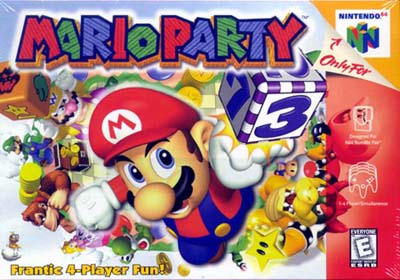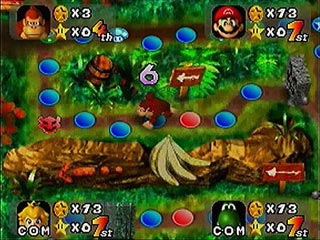Mario Party
Released: December 18, 1998
Mario Party is the first in a series of board game style video games for Nintendo platforms, featuring popular characters from the Mario series. It was released on the Nintendo 64 in North America on February 8, 1999 following a Japanese release on December 18 , 1998 . It was released in Europe on March 9 , 1999 . The game has "spawned" seven sequels with Mario Party 8 as the most recent one, as well as Arcade , Game Boy Advance , and e-Reader versions, making a total of eleven games in the series.

Gameplay takes the form of a traditional board game, with players taking turns to roll the dice (dubbed a "diceblock") and move ahead the number of spaces shown. There's many different types of spaces players can land on, each producing a different effect. The primary objective of the game is to collect more stars than any other player. The winner of the game is the player with the most stars after all the turns have been completed.
A secondary objective is to gather coins, as well, for they are necessary for buying essential items such as stars and determine the game winner in the event of a tie. Coins are earned from landing on blue spaces, from passing the start point, and from winning mini games. They're lost from landing on red spaces, from passing Bowser and from losing mini games. They can also be stolen from other players who pass Boo and ask him to steal coins from you.
Only one star is present on the board at a given time, appearing randomly on a space on the board where it remains until bought by a player for 20 coins from Toad . After a star is collected, a new one appears on a different space on the game board. Stars can also be stolen from other players by passing a certain location on the board where a Boo resides - the player must then pay Boo 50 coins for the service. At the end of each round of play (ie. after each of the four players have taken their turn) a random mini-game commences. At the end of the entire game there's three bonus stars: one is given to the player who collected the most coins overall, one is given to the player who collected the most coins in mini-games, and one given to the player who landed on the most "?" spaces (which are spaces that, if landed on, certain pre-determined events take place). The person with the most stars is declared the winner. In the event of a tie, the player with the most coins wins.
Mini-games happen at the end of each round or occasionally during a round when a player lands on Bowser or 1-player mini-game spaces. The mini-games are generally short (about a minute in length), and fairly simple. There's 50 of them in all and they're divided into 4 different categories:
- Four-player mini-games may be divided into three types:
- the cooperative games, in which all four players collectively win or lose
- the competitive free-for-alls, in which players must compete against each other in order to win a limited number of coins
- the non-competitive free-for-alls, in which players accrue coins independently of one another and one player's loss is not automatically another's gain.
- 2-on-2 mini-games place players on teams, so they have to cooperate with others in the mini game to win (even though they're still competing against each other in the main game)
- 1-on-3 mini-games have a team of three against a lone player. Often, the game's objective is for either the lone player or the team of three to survive for a certain amount of time while the opposing player/team tries to take them out. The team of three must cooperate in order to win.
- 1-player mini-games only occur during a round when a player lands on a 1 player mini-game space. They give a single player an opportunity to earn (or lose) coins depending on his or her performance in the mini-game.
In most situations, the winner(s) of a mini-game receive ten coins for their victory. In some mini-games, the losing player(s) have to pay the winner(s) a sum of coins.

Modes
Adventure Mode
The standard mode of play, as described in Gameplay above. Up to four players play a board game interspersed with mini games, trying to collect as many stars as possible by the end of a set number of turns. The coins and stars earned in Adventure Mode are tallied up and transferred to a fund which the player can use to unlock things in the game.
The type of mini-game (4 player, 1 vs. 3, and 2 vs. 2) is determined by what color the players' panels are. If all four players have the same color panels, a 4 player game is selected. If there's 1 blue panel and 3 red panels or vice versa, a 1 vs. 3 game is selected. If there's 2 panels of both colors, a 2 vs. 2 game is selected. If there's a green panel, the color will switch to either red or blue randomly.
- Boards in Adventure mode
Mario Party contains the greatest number of boards in the series (discounting the duel boards in Mario Party 3 ). The boards in the game are non-linear, contain multiple paths, and offer things that can be bought or interacted with to provide the player with an advantage. After finishing a game, the winner fixes whatever trouble was plaguing the board in the ending celebration.
-
- Mario's Rainbow Castle - Mario
- Luigi's Engine Room - Luigi
- Peach's Birthday Cake - Princess Peach
- Yoshi's Tropical Island - Yoshi
- Wario's Battle Canyon - Wario
- DK's Jungle Adventure - Donkey Kong
- Bowser's Magma Mountain (Unlocked by buying at the shop) - King Bowser
- Eternal Star (Unlocked by collecting 100 stars)
Mini-game Island
A one-player mode in which the player navigates a world map and tries to win mini games in order to progress across the map. Winning mini games gives the player coins, and collecting 100 coins grants the player a life. Losing a mini game causes the player to lose a life. If the player loses all of his lives, the game ends, and the player must resume from where he or she last saved.
Mini-game House
An area in which up to four players can compete by playing mini games. Players can select to play 1, 3, 5, or 7 mini games of any type in a row. At the end of the series of mini games, the player who has the most coins wins. In the Mini Game House, players can choose to play any mini games that they've previously played in Adventure Mode. They can play the mini games for free if they've purchased them (by paying a once-off fee varying from 100 to 500 coins), or by paying a rental charge of 5 coins if they haven't.
The Mini-game House also contains the Mini-game Stadium, a simple board map in which up to four players compete to try to earn the most coins by winning minigames. No stars are given out in this mode and no coins are gained or lost by landing on red and blue spaces.
The Mecha Fly Guy challenge, a game in which a player must rotate the control stick as many times as possible within a 10 second time period in order to make the Mecha Fly Guy fly as far as possible, is also found in the Mini-game House.

